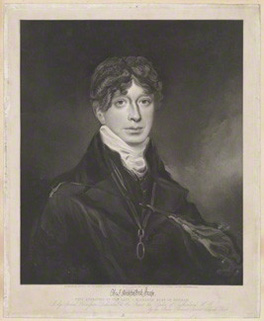Hello! Ask me (almost) anything about traditional music.
Annotation:Miss Sharp’s Fancy
X:2 T:Miss Sharpe’s Fancy M:6/8 L:1/8 R:Jig or Air C:Charles Sharpe B:Gow – 3rd Collection of Niel Gow’s Reels, 3rd ed., p. 4 (orig. 1792) Z:AK/Fiddler’s Companion K:D f|{c}d2A AFA|{G/A/}B2A AFA|{B/c/}d2A {B}AGF|ECA, TA,2 B/c/| B2A AFA|{G/A/}B2A ABc|d(gf) (ea)c|d3 Td2:|| f/g/|afd (df).a|ged (ce)g|fed {e}Tdcd|ecA A2 (f/g/)| afd dfa|ged (ce).g|(fa).d (eg).c|{c}d3 Td2 f/g/| afd (df)a|ged (ce)g|fed {f}Tdcd|ecA TA2G| (FA).d (FA).d|(GB).d (GB).d|(Ag).f (ea).c|{c}Td3 D2||
MISS SHARPE'S FANCY. AKA – "Miss Sharpe's Favourite." Scottish (originally), Irish; Jig. D Major. Standard tuning (fiddle). AAB (Carlin, Gatherer): AABC (O'Neill). Composed by Charles Sharpe (1749–1813) of Hoddam (sometimes 'Hoddom' or 'Haddam'), in honor of his daughter. Sharpe was the son of William Kirkpatrick of Ailsland, a younger brother of Sir Thomas Kirkpatrick, 3rd Baronet of Closeburn. On inheriting Hoddam Castle [1], Dumfriesshire, in the Borders, Charles changed his name to Sharpe, the name of his uncle’s line, from whom he inherited the estate. He set to work on the castle, repairing and improving it, and adding several rooms. Sharpe had a reputation as an excellent violinist, and also composed music and verse. He was a friend and correspondent of Robert Burns and Sir Walter Scott (See “Mr. Sharpe's Delight” for more). Miss Sharpe’s mother was Eleonora, daughter of John Renton of Lamberton, and a lady whose beauty is celebrated in Tobias Smollet's (1721-1771) picaresque novel The Expedition of Humphrey Clinker [2] (1771). See also McIntosh's "Miss Sharpe of Hoddom's Reel."

The Sharpe's had two children, the eldest being Charles Kirkpatrick Sharpe, a noted antiquarian and man of letters. The younger was Jane Kirkpatrick Sharpe (1773–1818), presumably the subject of this tune. She was born in 1773, and married her second cousin Sir Thomas Kirkpatrick (1777–1844), Baronet, sheriff of Dumfries-shire, in St. Andrews Church, Edinburgh, Scotland in 1804. They had seven children. She died at Capenoch, Thornhill, Dumfries, Scotland.


